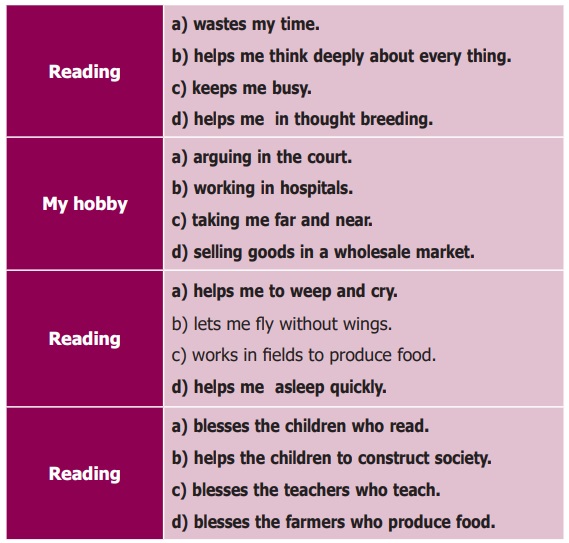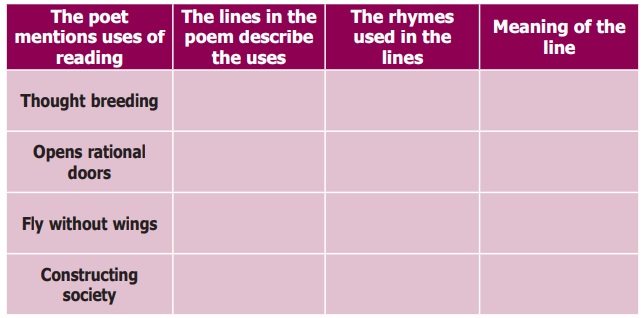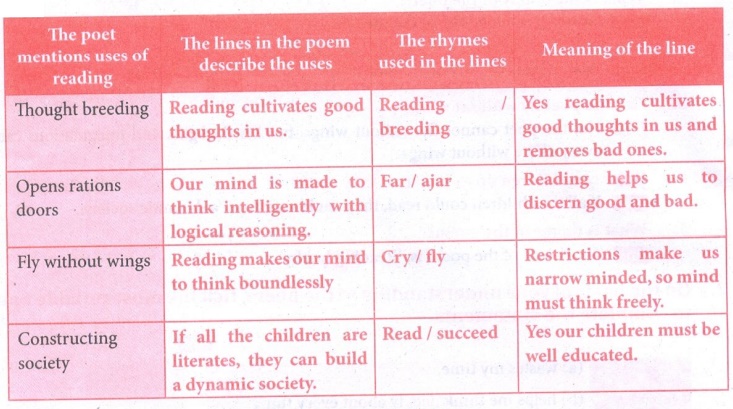My Hobby: Reading - Poem by Arunachalam Chandrasekharan - Unit 2 - 8th English - Questions Answers | 8th English : Unit 2 : Poem : My Hobby: Reading
Chapter: 8th English : Unit 2 : Poem : My Hobby: Reading
Questions Answers
Poem
My Hobby: Reading
1. Comprehension Questions.
1. What is the hobby of the poet?
Answer: Reading is the hobby of the poet.
2. What does ‘ajar’ mean?
Answer: ‘Ajar’ means slightly open door.
3. Can the poet fly without wings?
Answer: No, the poet cannot fly without wings, but his thoughts and imaginations can fly everywhere without wings.
4. What can children do to society if they read?
Answer: If all the children could read, they could construct a dynamic society.
5. What is the theme of the poem?
Answer: The theme of the poem is, ‘Reading hobby’.
2. On the basis of your understanding of the poem, tick the most suitable option to complete the statements.

Reading
a) wastes my time.
b) helps me think deeply about every thing.
c) keeps me busy.
d) helps me in thought breeding.
My hobby
a) arguing in the court.
b) working in hospitals.
c) taking me far and near.
d) selling goods in a wholesale market.
Reading
a) helps me to weep and cry.
b) lets me fly without wings.
c) works in fields to produce food.
d) helps me asleep quickly.
Reading
a) blesses the children who read.
b) helps the children to construct society.
c) blesses the teachers who teach.
d) blesses the farmers who produce food.
3. Complete the table given below in order to understand the poem better.


FIGURE OF SPEECH
A ‘Figure of Speech’ is a word or a phrase which gives a separate meaning from the normal one. It means something more than it seems to mean. It is used figuratively, to give an implied meaning to the given context. It can either be used to make comparisons, or even to insist repetition or exaggeration. Figures of speech provide a dramatic effect.
A. Rhyming words
‘Rhyming words’ are two or more words which have the same sound. Words ‘rhyme’ if they have similar sounds when said aloud. ‘Rhyming words’ usually occur at the end of the lines in a poem. Rhyming words make poems or songs fun to sing.
A Tiny Little Plant
Deep in the heart of a little seed,
Lay buried so, so deep,
A tiny little plant fast asleep.
Out came the bright Sunshine,
Down crept its light,
Into the seed, too bright.
A little plant woke up to see,
How bright the world might be.
Answer the following:
1. List the rhyming words in the first three lines.
Answer: The rhyming words - deep - asleep.
2. Which word in the poem rhymes with 'light'?
Answer: “bright”.
B. Rhyme Scheme:
A ‘Rhyme Scheme’ is a specific pattern used in a poem which determines which lines rhyme in the poem. Poets write poems with a rhyme scheme or a pattern. It is the arrangement of rhymes in a poem or a stanza.
Example:
Upon a nice mid-spring day, a
Let’s take a look at Nature’s way, a
Breathe the scent of nice, fresh air, b
Feel the breeze within your hair. b
The grass will poke between your toes. c
Smell the flowers with your nose. c
Clouds form shapes within the skies. d
And light will glisten from your eyes. d
The rhyme scheme of this poem can be determined by the end word in each line. The first line ends with the word ‘day’ and the second line ends with ‘way’. As both words rhyme with other, they are given the letter ‘a’. The third line ends with the word ‘air’ and the fourth line ends with ‘ hair’. These two words do not rhyme with the ending words of the first two lines. So, they are given the letter ‘b’ and so on. We get a rhyme scheme aabb ccdd for this poem.
Answer the following:
a. Identify the rhyme scheme of the given short poem.
My dog likes bones,
He eats them up,
He’s very sweet,
He’s just a pup.
Answer: a b c b.
b. Complete this poem on your own with a abab rhyme scheme.
Peas porridge hot,
Peas porridge cold,
Answer:
Peas porridge in the pot
Nine days old.
ADDITIONAL QUESTIONS
Poem Comprehension
1. My hobby is reading
It helps me
In thought breeding.
It takes me to places
Near and far,
It keeps my rational
Doors ajar.
(a) What does the word ‘rational’
mean?
Answer: ‘Rational’ means
intelligence.
(b) Pick out the rhyming words in
these lines.
Answer: The rhyming words : Reading - breeding; far - ajar.
(c) How does reading help the poet?
Answer: Reading helps the poet
to grow and cultivate good thoughts.
(d) Whose hobby was reading in the
poem ‘My Hobby’?
Answer: Reading was the hobby
of the poet Arunachalam Chandrashekaran.
(e) What does the term ‘thought
breeding’ mean?
Answer: The term ‘thought
breeding’ means cultivating many good thoughts in a person whose hobby is
reading.
(f) How does reading take the poet
near and far?
Answer: When the poet reads
about a content related to something near him and when he reads a content of
something far, it takes him near and far.
(g) What are ‘rational doors’?
Answer: The poet compares his
mind to a room and reading habit are the doors of his mind.
2. It teaches me
To cackle and cry
Without wings
It lets me fly.
(a) Why should reading teach us both
to laugh and cry?
Answer: Life is made of both
joy and sorrow. Reading helps us to take both equally.
(b) How does the poet fly?
Answer: The poet does not fly
physically in the air. His thoughts expand and fly in all directions.
3. I wish
If all the children
could read,
In constructing a
vigorous society,
Then we shall succeed.
(a) Who can build a vigorous
society?
Answer: The children can build
a vigorous society.
(b) How can we succeed?
Answer: We can succeed, if we
can build a dynamic, strong and powerful society.
(c) Pick out the alliterated words.
Answer:
‘shall
- succeed’ are the
alliterated words.
Short Questions and
Answers.
1. How does his hobby help him ?
Answer: His hobby helps him to cultivate many good thoughts.
2. Where does the reading take him ?
Answer: Reading takes him to
the nearby as well as to the far and remote places.
3. What does reading teach him ?
Answer: Reading teaches him to
laugh loudly and at the same time even to cry.
Paragraph Questions
with Answers.
1. What are the five ways in which
reading helps us?
Answer: Reading hobby helps us
to grow and cultivate many good thoughts. The content we read not only takes to
nearby places but also to the remote and far areas according to what we read.
Reading habit enables
to keep the doors of our mind unlocked and half open to permit intelligent and
logical reasoning at the same time to prevent unwanted entry of bad and wrong
things. Reading practices us to take in both happiness and sorrow in the same
spirit. It teaches us to laugh loudly during happy times and to cry and let out
sorrow during painful times.
Reading does not
restrict or control our thoughts. Without wings it allows our thoughts to soar
high and fly.
2. How can we form a ‘vigorous
society’ according to the poet?
Answer: According to the poet
Arunachalam we can form a vigorous - active, strong, healthy and a dynamic
society if all the children cultivate a reading habit, go to school, study and
are educated. In such a society the people will be successful, prosper and
flourish.
Poetic Devices in this
poem.
The poet uses the
following poetic devices in his poem, ‘My Hobby : Reading’.
1. Imagery The poet weaves the
advantages of reading hobby in his imagination.
a) The poet does not physically
travel ‘near and far’, only his thoughts travel.
b) There is no literal
door, the poet imagines his minds entrance as ‘door’,
c) The poet does not
fly in the air. His thoughts, imaginations and ideas only made to ‘fly’ by his
reading hobby.
2. Rhyme : This short poem has
the following rhyming words:
Lines 1
reading, breeding
Lines 5-8
far, ajar
Lines 9-12
cry, fly
Lines 13-15
read, succeed
3. Couplet: It is a fifteen-line
poem. Each couplet after the first line presents a different thought concept.
Example: Line 2, 3
tells about thought breeding, line 4,5 speaks of ‘rational door’.
Line 6, 7 about joy and sorrow, lines 8,9 flying without wings.
Related Topics